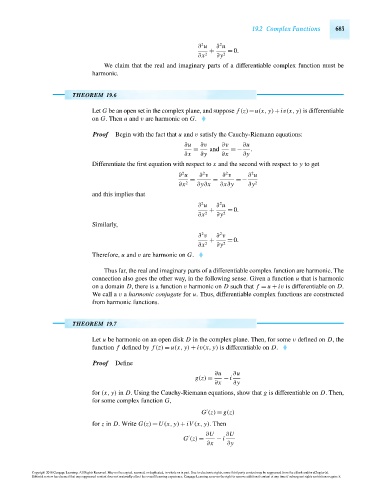Page 703 - Advanced_Engineering_Mathematics o'neil
P. 703
19.2 Complex Functions 683
2
2
∂ u ∂ u
+ = 0.
∂x 2 ∂y 2
We claim that the real and imaginary parts of a differentiable complex function must be
harmonic.
THEOREM 19.6
Let G be an open set in the complex plane, and suppose f (z)=u(x, y)+iv(x, y) is differentiable
on G. Then u and v are harmonic on G.
Proof Begin with the fact that u and v satisfy the Cauchy-Riemann equations:
∂u ∂v ∂v ∂u
= and =− .
∂x ∂y ∂x ∂y
Differentiate the first equation with respect to x and the second with respect to y to get
2
2
2
2
∂ u ∂ v ∂ v ∂ u
= = =−
∂x 2 ∂y∂x ∂x∂y ∂y 2
and this implies that
2
2
∂ u ∂ u
+ = 0.
∂x 2 ∂y 2
Similarly,
2
2
∂ v ∂ v
+ = 0.
∂x 2 ∂y 2
Therefore, u and v are harmonic on G.
Thus far, the real and imaginary parts of a differentiable complex function are harmonic. The
connection also goes the other way, in the following sense. Given a function u that is harmonic
on a domain D, there is a function v harmonic on D such that f = u + iv is differentiable on D.
We call a v a harmonic conjugate for u. Thus, differentiable complex functions are constructed
from harmonic functions.
THEOREM 19.7
Let u be harmonic on an open disk D in the complex plane. Then, for some v defined on D,the
function f defined by f (z) = u(x, y) + iv(x, y) is differentiable on D.
Proof Define
∂u ∂u
g(z) = − i
∂x ∂y
for (x, y) in D. Using the Cauchy-Riemann equations, show that g is differentiable on D. Then,
for some complex function G,
G (z) = g(z)
for z in D. Write G(z) = U(x, y) + iV (x, y). Then
∂U ∂U
G (z) = − i
∂x ∂y
Copyright 2010 Cengage Learning. All Rights Reserved. May not be copied, scanned, or duplicated, in whole or in part. Due to electronic rights, some third party content may be suppressed from the eBook and/or eChapter(s).
Editorial review has deemed that any suppressed content does not materially affect the overall learning experience. Cengage Learning reserves the right to remove additional content at any time if subsequent rights restrictions require it.
October 15, 2010 18:5 THM/NEIL Page-683 27410_19_ch19_p667-694

